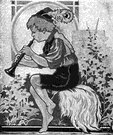half·tone
(hăf′tōn′, häf′-)n.
1. A tone or value halfway between a highlight and a dark shadow.
2.
a. A picture in which the gradations of light are obtained by the relative darkness and density of tiny dots produced by photographing the subject through a fine screen.
b. A picture made by such a process.
3. Music See semitone.
American Heritage® Dictionary of the English Language, Fifth Edition. Copyright © 2016 by Houghton Mifflin Harcourt Publishing Company. Published by Houghton Mifflin Harcourt Publishing Company. All rights reserved.
halftone
(ˈhɑːfˌtəʊn)n
1. (Printing, Lithography & Bookbinding)
a. a process used to reproduce an illustration by photographing it through a fine screen to break it up into dots
b. the etched plate thus obtained
c. the print obtained from such a plate
2. (Art Terms) art a tonal value midway between highlight and dark shading
3. (Music, other) music US and Canadian another word for semitone
adj
(Printing, Lithography & Bookbinding) relating to, used in, or made by halftone
Collins English Dictionary – Complete and Unabridged, 12th Edition 2014 © HarperCollins Publishers 1991, 1994, 1998, 2000, 2003, 2006, 2007, 2009, 2011, 2014
half•tone
(ˈhæfˌtoʊn, ˈhɑf-)n.
1. (in painting, drawing, graphics, photography, etc.) a value intermediate between light and dark.
2.
a. a printing process in which gradation of tone is obtained by a system of minute dots.
b. the metal plate used in such a process.
c. the print obtained in such a process.
3. semitone.
[1645–55]
half′tone, adj.
Random House Kernerman Webster's College Dictionary, © 2010 K Dictionaries Ltd. Copyright 2005, 1997, 1991 by Random House, Inc. All rights reserved.
halftone
Any photomechanical printing surface or the impression therefrom in which detail and tone values are represented by a series of evenly spaced dots in varying size and shape, varying in direct proportion to the intensity of the tones they represent. See also halftone screen.
Dictionary of Military and Associated Terms. US Department of Defense 2005.
ThesaurusAntonymsRelated WordsSynonymsLegend:
| Noun | 1. |  halftone - a print obtained from photoengraving halftone - a print obtained from photoengravingengraving - a print made from an engraving |
| 2. |  halftone - an engraving used to reproduce an illustration halftone - an engraving used to reproduce an illustrationengraving - a block or plate or other hard surface that has been engraved |
Based on WordNet 3.0, Farlex clipart collection. © 2003-2012 Princeton University, Farlex Inc.